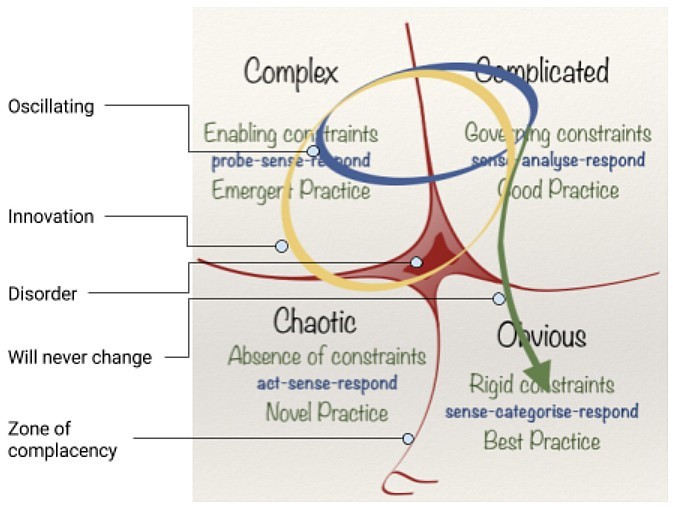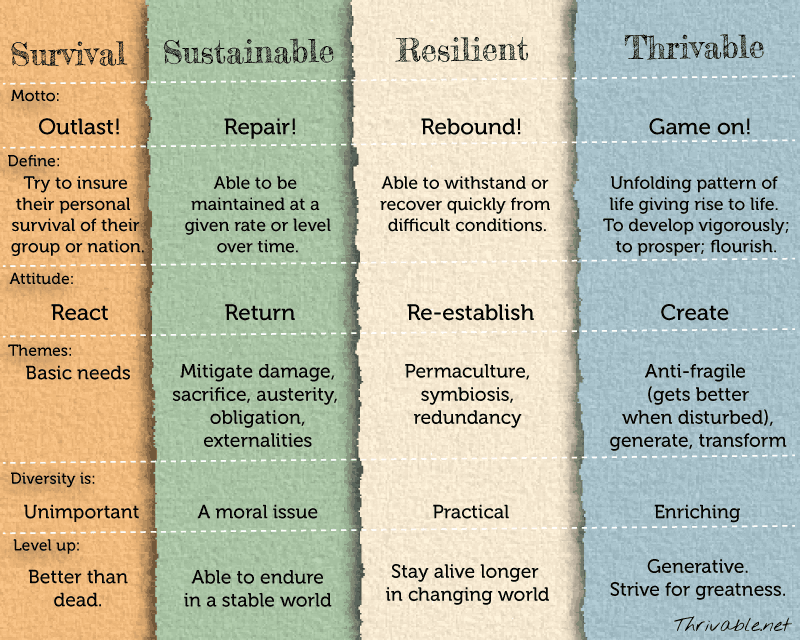[ap_spacing spacing_height=”15px”]
* * *
Many people have asked how their network can function when organizations remain in their traditional hierarchical structures. Sahana’s post explains how organizations, especially those in networks, need to shift and change. – June
* * *
Part 1
Designing orgs as communities make for responsive, thrivable organizations
[ap_spacing spacing_height=”10px”]

[ap_spacing spacing_height=”10px”]
The very definition of organizations has changed. The impact of digitization is going far beyond a few collaboration tools and platforms. Today’s organizations are no longer defined by fixed workplaces, nine-to-five working hours or even a set of homogeneous employees. Organizations have become boundary-less and often, location agnostic and virtual. Operational and business models have been turned on their heads with the advent of enterprises like Uber, Airbnb, Etsy and Amazon. And no industry is immune to this disruption — from education to retail, from healthcare to hospitality — the old business models are being rapidly upended by new ones. We have entered the Black Swan era with un-directed and unpredictable events regularly cropping up. These complexities are continuing to exponentially increase as we enter a hyper-digital era with AI, Robotics, 3D printing, Wearables, Alternate Reality and VR, and much more looming over the horizon. Some of the key shifts were identified by Dr. Lynda Gratton in her book, The Shift, and are depicted in the diagram below:
[ap_spacing spacing_height=”10px”]

[ap_spacing spacing_height=”10px”]
These paradigm shifts are causing wide-scale disruption in our personal and professional lives, and reflect an urgent need to rethink and re-imagine the workplace in order to take advantage of the affordances offered by the digital era. This is not merely about implementing a few collaboration tools or putting in place an Enterprise Social Network (ESN) with the diktat to “collaborate”. It requires a complete re-hauling of how business gets done. Organizations have to leverage the power of design thinking and emergent technology to create spaces where everyone can bring in their fullest potential. Going ahead, organizations of the future will possibly function as Transformative Communities connecting diverse, distributed and multi-talented individuals who will come together to move toward an Evolutionary Purpose.I will write more about the evolutionary purpose and transformative communities in my future posts.
The need for organizations to function as communities of passionate and purpose-driven individuals is becoming even more critical in the face of unprecedented upheaval being faced at local, global and planetary levels. Top down, hierarchical, command and control organizations just do not have the agility or the resilience to meet the needs of today. As the world becomes increasingly connected and networked, it calls for organizations that are equally networked and decentralized. An organization’s communities today would not be restricted to its internal employees but would extend to include contractual and contingent workers, partners, vendors and suppliers, and also customers and competitors — the extended enterprise. I would also add the Planet and all sentient beings since every decision taken has a ripple effect with the capacity to impact millions far away from the origin of the organization. For example, the massive expansion of palm oil plantations in Borneo and Sumatra are directly threatening the survival of orangutan population in the wild. We are all well versed with the Butterfly Effect. Hence, this “extended enterprise” is as critical to the sustainability — nay, the Thrivability — of the business as any direct employee/shareholder. It’s no longer enough to build an organizing that survives or is even just sustainable. The former implies a closed view/self-focus and the latter implies an organization that is just maintaining itself. A thrivable organization is anti-fragile, holds space for emergence and creates opportunities for the thriving of others, and flows with the change.Perhaps it is time for organizations to pause and ask:
How can an organization be designed such that it becomes a space that nurtures, supports and enables conditions of thriving?
The diagram below created by Jean Russell highlights the differences…
[ap_spacing spacing_height=”10px”]
[ap_spacing spacing_height=”10px”]
A lack of Systems Thinking and understanding of Complex Adaptive Systems coupled with the desire/pressure for limitless growth have led organizations toward the kind of tunnel vision which has collectively led us to a place no one wanted to reach. I am emphasizing on organizations becoming communities because communities allow us to tap into Collective Intelligence from a diverse pool of people without the constraint of hierarchy, permission and rigidity. To be an evolutionary and purpose-driven organization and to engage in situations we do not have a roadmap for, it is important to seek/curate collective intelligence.
However, the underlying business processes, managerial strategies, and workplace protocols still adhere to mechanistic, Industrial Era paradigms with performance, speed and bottom line being the drivers. These, needless to say, lead to short term thinking, repeating of past patterns, loss of innovation, frustration and burnout, and a joyless work environment. By sticking to Industrial Era processes when that era is long gone, organizations threaten their own survival. Viewing an organization through the lens of a machine and people as cogs worked when the world was predictable, change happened very slowly, lessons of yesterday became best practices of today, and assembly line production ruled the day. Gone is that era. The 90’s brought the term VUCA into our consciousness. And the last decade has seen a veritable tsunami of change. Technology is taking us to a world that is science-fiction-like in its possibilities. But everything will come to naught if the patterns, mindsets and underlying consciousness guiding us continue to remain static. Our organizations today are rooted in the past while the future is already here. Unless we are cautious, we will run the risk of using technology to amplify and empower old systems and processes (faster production, greater efficiency, higher bottom line) while the organization gradually becomes less human, and we come face-to-face with our own Frankenstein. As we lose our humanity to the glitzy appeal of speed and technology, so will we lose our interconnectedness with each other and all sentient beings.
The power of technology is immense. The choice is ours — whether we use it to amplify our humanity and connectedness to each other and the planet or we use it to further short-term profits at the cost of humanity and all sentient beings.
Never in the past have we had such unprecedented opportunities to connect thousands, millions of people together. Never in the past did an organization have the platforms and technology necessary to build communities of passionate, diverse, globally dispersed and differently skilled individuals. Organizations now have the power to move from building teams to enabling evolutionary co-creating communities.
My next post will focus on how to move towards building communities, overcome obstacles and envision what such a re-imagined workplace could look like.
[ap_spacing spacing_height=”20px”]
Part 2
Exploring how communities enable sensemaking and emergence in organizations
Yesterday, in a Twitter conversation with Rachel Happe regarding the need for organizations to function as communities, I wrote the following: “Complicated solutions are yesterday’s good practices. Complex, holistic solutions are multi-faceted, emergent and constantly evolving. They can’t be pinned down by rules but have to be sensed into through open dialogues.”
This reminded me of one of my favorite frameworks — the Cynefin framework designed by Dave Snowden in 1999. Cynefin is a Welsh word meaning habitat; the framework is simple and elegant but leads us to profound insights. If we see the framework below, we can easily see where we are today as humanity and where we are headed. The habitat for organizations has moved from being complicated to complex with exponentially increasing rate of change (Moore’s Law in action) and is rapidly heading towards the chaotic. As is evident, rules, processes, constraints and good practices worked perfectly for the complicated, mechanistic Industrial Era. However, complexity requires Systems Thinking and “enabling constraints”. I interpret enabling constraints as “holding space for emergence” where constraints function as a safety net.
[ap_spacing spacing_height=”10px”]

[ap_spacing spacing_height=”10px”]
This is where things get tricky. Leaders today are geared to respond to challenges with speed and action. The hierarchical structure of most organizations places a few people at the top charged with all critical decision-making, thus losing out on the vast capacity of the collective intelligence available throughout the organization. And, ironically, in the face of increasing complexity and uncertainty, there is more pressure to deliver “results” and “do something” to allay the situation. What of course ends up happening is the putting of band-aids over symptoms while the root causes go un-examined, unexplored, and left to proliferate. While it is counter-intuitive, complexity requires us to slow down— to probe, sense, and then respond. It requires us to go from rapid-fire action to observation, reflection, and thoughtful response when the time is right.
How are communities connected to complexity, collective intelligence and “sensemaking”?
I propose that in the context of pervasive complexity and ambiguity, communities of passionate, connected and purpose-driven individuals can illuminate the way forward. Communities are different from typical project teams who come together for an explicit outcome, work towards their objectives, and when the work is done, it’s done. I am not denying the value of great team work having been a part of some amazing teams myself. However, I am focusing on communities here because communities come together and cohere very differently. They are usually aligned around a purpose larger than each individual; membership is usually voluntary which means people go where they are drawn to go. Diverse people connect who may “normally” not have known each other, creating greater opportunities for serendipity and innovation. Communities allow lurkers to also exist within its ecosystem, something teams cannot do. I believe lurkers carry immense value as they often become channels of cross-pollination between communities and are a critical part of the weak-tie network making a community more diverse, resilient and porous. And most importantly, communities carry a sense of belonging to something beyond the self. All of these contribute to make communities adept at feeling into the ecosystem, seeing the system through different lenses, caring about the system, and responding to the emergent with deeper insight. This is what tapping into the power of collective intelligence is about.
[ap_spacing spacing_height=”10px”]

[ap_spacing spacing_height=”10px”]
Therefore, when an organization functions as a collective of networked communities, its ability to probe and sense its ecosystem increases manifold. It is akin to a human using all our five senses as well as the heart and the gut as opposed to only our rational ability. In the diagram below, I have tried to represent an organization as an open system connected via today’s ubiquitous technology. Imagine an organization whose boundaries are porous, giving it the capacity to fluidly exchange information with its ecosystem. Internally, the organization functions as clusters of communities which also have porous, permeable walls. The community members interact and connect through various means (some of which are shown in the diagram). This creates a system that is able to constantly sense and see itself, can connect its edges to its center and hold complexity by distributing it in the network.This ability to tap into the collective intelligence and wisdom of the whole makes a system/organization resilient, anti-fragile, and eventually thrivable. This requires viewing the organization as a living system that has the capacity to adapt, heal itself, and thrive given the right conditions.
I admit though that this is easier said than done. I have written about some of the obstacles to building communities here. Apart from the technology and the roles of community facilitators, this shift requires re-imagining and reinventing the structures, processes, and the culture as well as the underlying narratives of an organization. All of this are the glue that hold the fabric of the organization together in its current state, and exert powerful resistance to anything that threatens the status quo. I am not saying the shift is easy at all. However, as global trends and patterns threaten to plunge us into chaos, it is time to rethink and re-imagine our organizations. It requires us to move from holding a few leaders at the top accountable and responsible for all decision, actions, and their intended and unintended consequences. We are well aware that complexity cannot be tackled through planning, controlling, resource management, and other known and popularized forms of management and leadership. Complexity calls for leaders to become facilitators, to hold space, to flow with uncertainty, to let leadership emerge from the collective, and to be able to sense the system. Leadership’s role becomes that of designing and holding the container for exploration and the emergence of future potential. All of these capacities come not only from experience but also from deep reflection and inner work. In the section below, I have discussed — what I believe — are some of the mindsets/capacities required of the leaders if they wish to design for thrivability.
[ap_spacing spacing_height=”10px”]

[ap_spacing spacing_height=”10px”]
- Holding space for Emergence — This involves creating the conditions and preparing the soil (the ethos/culture) for dialogues to take place. This requires the capacity to be comfortable with the discomfort of staying in the liminal space, and not forcing a pre-defined outcome when a problem rises to the surface. It’s also the ability to see problems as gifts/messages calling the organization’s attention to what needs to shift. And using processes like The Circle Way, the U Process, and Liberating Structures to have generative conversations. [ap_spacing spacing_height=”10px”]
- Staying with Uncertainty — While close to the above capacity, I have deliberately called it out separately as well. Leaders have the propensity and are often expected to provide answers in times of great uncertainty and upheaval. Staying with uncertainty conversely requires leaders to strengthen their muscles for staying in the space between stories, suspending judgement, being ok with not having any answer, and tapping into one’s inner guidance till a response naturally surfaces. And as leaders develop and operate from these capacities within themselves, the core skills permeate throughput the organization with support. [ap_spacing spacing_height=”10px”]
- Creating space for Synchronicity — In the rush of solving daily challenges and focusing on short term goals, we all forget to slow down and stay with the emerging. Welcoming synchronicity require us to hold space for ourselves as well as others, to tap into our inner wisdom and allow the unfolding to happen. I can best describe it as a shift from doing to being. It’s in the in-between space when we let go of control and trust in a higher order do we begin to experience the synchronicity that come our way as guideposts.[ap_spacing spacing_height=”10px”]
- Operating from Inter-connectedness — I firmly believe in the concept of “Interbeing” described by Thich Nhat Hanh. His definition of “seeing clouds in a piece of paper” is the quintessential and an eloquent description of Systems Thinking. It is essential for leaders to operate from this space of inter-connectedness and the whole lest the fixing of a problem in one part of the system creates unintended consequences in another part, and maybe elsewhere in the ecosystem too.[ap_spacing spacing_height=”10px”]
- Sacrificing an Expert’s Mindset — Most of us are aware of the Japanese concept of shoshin articulated by Shunryu Suzuki as, “In a beginner’s mind there are many possibilities, in an expert’s mind very few.” One of the fundamental capacities for holding space is to let go of the expert’s mindset, and also one of the most difficult. It means a letting go of the ego and all other credentials that has brought us to our current state of power, position, and privilege. This letting go is essential to foster openness. An expert’s mind will not be able to create space for emergence.[ap_spacing spacing_height=”10px”]
- Facilitating Generative Conversations — I strongly recommend going through and practicing the four levels of listening and conversing defined by Otto Scharmer in his book, The Essentials of Theory U. A capacity and willingness to move beyond the downloading and factual to empathic and generative is essential to bring collective intelligence and creativity in the service of a greater good. In the first two situations, no new learning or insight can emerge as we stay stuck in false harmony or debate/compromise, respectively. They only serve to keep the system stuck in the old patterns and habits. The next two — empathic and generative listening — open up the field of the future and lead to emergent practices. I have included the diagram below for reference.
As would have occurred to most of you’ll reading the post, the capacities mentioned above require not only deep reflection and inner work but also great empathy, curiosity, courage, and compassion. Only by holding ourselves and others with open compassion and acceptance can we even begin to create the conditions for thrivability. I’ll deep dive into these aspects in future posts.
The next questions are: “Despite the phenomenal capacities of technology today, is technology the only solution? How important are connections in person? How critical is it for us to experience our inter-connectedness with nature? How do we balance the virtual world with the real world we inhabit?”
I’ll explore these questions in my next post. You can read the Part 1 of Organizations as Communities here.
[ap_spacing spacing_height=”10px”]
Part 1 originally published on Sahana Chattopadhyay’s Medium page HERE
Part 2 originally published on Sahana Chattopadhyay’s Medium page HERE
